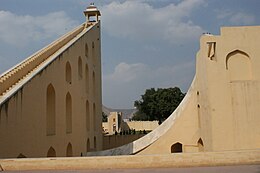
A sundial is a horological device that tells the time of day when direct sunlight shines by the apparent position of the Sun in the sky. In the narrowest sense of the word, it consists of a flat plate and a gnomon, which casts a shadow onto the dial. As the Sun appears to move through the sky, the shadow aligns with different hour-lines, which are marked on the dial to indicate the time of day. The style is the time-telling edge of the gnomon, though a single point or nodus may be used. The gnomon casts a broad shadow; the shadow of the style shows the time. The gnomon may be a rod, wire, or elaborately decorated metal casting. The style must be parallel to the axis of the Earth's rotation for the sundial to be accurate throughout the year. The style's angle from horizontal is equal to the sundial's geographical latitude.

Jaipur is the capital and the largest city of the north-western Indian state of Rajasthan. As of 2011, the city has a population of 3.1 million, making it the tenth most populous city in the country. Located 268 km from the national capital New Delhi, Jaipur is also known as the Pink City due to the dominant color scheme of its buildings in old city.
Paṇḍita Jagannātha Samrāṭ (1652–1744) was an Indian astronomer and mathematician who served in the court of Jai Singh II of Amber, and was also his guru.

Sawai Jai Singh II, was the 29th Kachwaha Rajput ruler of the Kingdom of Amber, who later founded the fortified city of Jaipur and made it his capital. He became the ruler of Amber at the age of 11, after the death of his father, Mirza Raja Bishan Singh, on 31 December 1699.

The Hawa Mahal is a palace in the city of Jaipur, Rajasthan, India. Built from red and pink sandstone, it is on the edge of the City Palace, Jaipur, and extends to the Zenana, or women's chambers.

Jantar Mantar is located in the modern city of New Delhi. "Jantar Mantar" means "instruments for measuring the harmony of the heavens". It consists of 13 architectural astronomy instruments. The site is one of five built by Maharaja Jai Singh II of Jaipur, from 1723 onwards, revising the calendar and astronomical tables. Jai Singh, born in 1688 into a royal Rajput family that ruled the regional kingdom, was born into an era of education that maintained a keen interest in astronomy. There is a plaque fixed on one of the structures in the Jantar Mantar observatory in New Delhi that was placed there in 1910 mistakenly dating the construction of the complex to the year 1710. Later research, though, suggests 1724 as the actual year of construction. Its height is 723 feet (220 m).

Indian astronomy refers to astronomy practiced in the Indian subcontinent. It has a long history stretching from pre-historic to modern times. Some of the earliest roots of Indian astronomy can be dated to the period of Indus Valley civilisation or earlier. Astronomy later developed as a discipline of Vedanga, or one of the "auxiliary disciplines" associated with the study of the Vedas dating 1500 BCE or older. The oldest known text is the Vedanga Jyotisha, dated to 1400–1200 BCE.

Medieval Islamic astronomy comprises the astronomical developments made in the Islamic world, particularly during the Islamic Golden Age, and mostly written in the Arabic language. These developments mostly took place in the Middle East, Central Asia, Al-Andalus, and North Africa, and later in the Far East and India. It closely parallels the genesis of other Islamic sciences in its assimilation of foreign material and the amalgamation of the disparate elements of that material to create a science with Islamic characteristics. These included Greek, Sassanid, and Indian works in particular, which were translated and built upon.
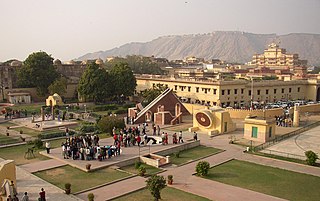
A Jantar Mantar is an assembly of stone-built astronomical instruments, designed to be used with the naked eye. There were five Jantar Mantars in India. All were built at the command of the Rajah Jai Singh II, who had a keen interest in mathematics, architecture and astronomy. The largest example is the equinoctial sundial belonging to Jaipur's assembly of instruments, consisting of a gigantic triangular gnomon with the hypotenuse parallel to the Earth's axis. On either side of the gnomon is a quadrant of a circle, parallel to the plane of the equator. The instrument can be used with an accuracy of about 20 seconds by a skilled observer to determine the time of day, and the declination of the Sun and the other heavenly bodies. It is the world's largest stone sundial, and is known as the Samrat Yantra. The Jaipur Jantar Mantar is a UNESCO World Heritage Site.
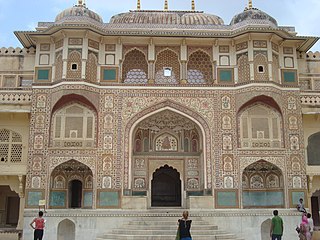
Jaipur District is a district in the state of Rajasthan in Northern India. The city of Jaipur, which is Rajasthan's capital and the largest city, is the district headquarters. It is the tenth most populous district in India.

Nahargarh Fort stands on the edge of the Aravalli Hills, overlooking the city of Jaipur in the Indian state of Rajasthan. Along with Amer Fort and Jaigarh Fort, Nahargarh once formed a strong defence ring for the city. The fort was originally named Sudershangarh, but it became known as Nahargarh, which means 'abode of tigers'. The popular belief is that Nahar here stands for Nahar Singh Bhomia, whose spirit haunted the place and obstructed construction of the fort. Nahar's spirit was pacified by building a temple in his memory within the fort, which thus became known by his name.
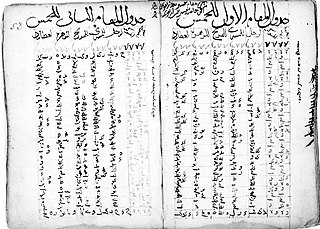
A zij is an Islamic astronomical book that tabulates parameters used for astronomical calculations of the positions of the sun, moon, stars, and planets.

Gyarah Sidi are the remains of the astrological observatory of the Mughal Emperor Humayun. The ruins are situated at a stone's throw from Babur’s Mehtab Bagh, in a field on the banks of the Yamuna river in Agra.
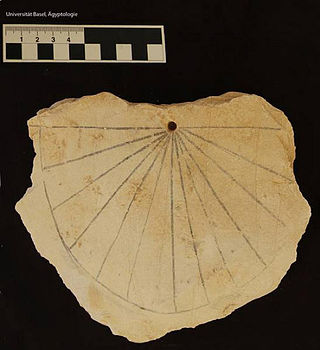
A sundial is a device that indicates time by using a light spot or shadow cast by the position of the Sun on a reference scale. As the Earth turns on its polar axis, the sun appears to cross the sky from east to west, rising at sun-rise from beneath the horizon to a zenith at mid-day and falling again behind the horizon at sunset. Both the azimuth (direction) and the altitude (height) can be used to create time measuring devices. Sundials have been invented independently in every major culture and became more accurate and sophisticated as the culture developed.

Mishra Yantra is an instrument in Jantar Mantar constructed between 1724 and 1730. A total of five Jantar mantars were constructed across North India in Jaipur, Delhi, Ujjain, Varanasi, and Mathura. They are one of the four astronomical instruments of the Jantar Mantar observatory located in New Delhi, India. Each instrument at Jantar Mantar are architecturally constructed based on mathematical observations, and help calculate celestial objects and time. The Mishra Yantra , is a compilation of five different instruments).

St. Xavier’s College Jaipur, is a Jesuit college in the city of Jaipur in Rajasthan, India. It was established in 2010, and is a co-educational, self-financed Catholic minority institution, affiliated to the University of Rajasthan. It offers undergraduate courses in arts, science, management, computers and commerce. The college also offers Master of Arts in English and Economics and Master of Commerce in EAFM and HRM.
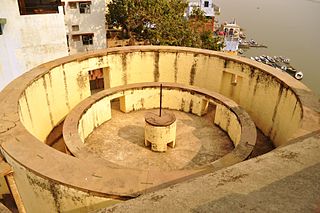
Jantar Mantar is an observatory built in Varanasi in the year 1737 by Maharaja Jai Singh II of kingdom of Amber. The observatory is one of the five built by Maharaja Jai Singh II.
Jantar Mantar is an Indian equinoctial sundial, consisting a gigantic triangular gnomon with the hypotenuse parallel to the Earth's axis.

Jantar Mantar or Vedh Shala is located in the holy city of New Ujjain. It is an observatory built by Maharaja Jai Singh II in 1725 which consists of 13 architectural astronomy instruments. The observatory is one of the five observatories built by Maharaja Jai Singh II when he was governor of Ujjain.

Nandivada Rathnasree or N. Rathnasree was an Indian astrophysicist, science communicator, and science historian, who was the director of India's Nehru Planetarium for over twenty years. She was responsible for improvements to the planetarium, as well as for researching the use of historical architectural astronomical instruments in India. She is known for her work in science communication.

